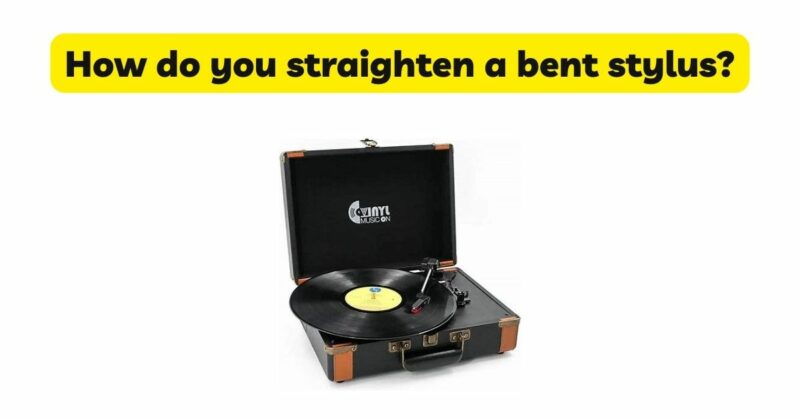The stylus is a critical component of a turntable setup, responsible for translating the grooves of a vinyl record into sound. However, accidents or mishandling can sometimes result in a bent or misaligned stylus. A bent stylus can negatively impact sound quality, tracking, and even cause damage to the record itself. In this article, we will explore various methods and precautions for straightening a bent stylus, providing step-by-step guidance to help you restore proper alignment and preserve the integrity of your vinyl collection.
- Assessing the Damage: Before attempting to straighten a bent stylus, it is essential to evaluate the severity of the bend and any potential damage. Consider the following factors:
a. Visual Inspection: Carefully examine the stylus under good lighting to determine the extent of the bend or misalignment. Look for obvious signs of damage, such as a visibly crooked or bent tip.
b. Playback Quality: Listen to a record and pay attention to any audible changes in sound quality, such as distortion, skipping, or excessive surface noise. These issues may indicate a misaligned or damaged stylus.
c. Record Inspection: Inspect the records played with the bent stylus for any visible signs of damage, such as scratches or groove deformations. These may suggest that the stylus has been causing unintended wear on the record surface.
- Handling Precautions: Before attempting any repairs, take the following precautions to prevent further damage:
a. Cleanliness: Ensure that your hands and work surface are clean and free from dust or debris. This reduces the risk of introducing contaminants to the stylus or record during the repair process.
b. Delicate Touch: Handle the stylus with care, avoiding excessive force or pressure. Exerting too much force can further damage the stylus or dislodge it from the cartridge assembly.
c. Turntable Power: Ensure that the turntable is powered off and unplugged before working on the stylus. This eliminates the risk of accidental movement or rotation, which can cause injury or damage to the stylus or cartridge.
- Straightening Methods: Depending on the extent of the bend or misalignment, you can attempt one of the following methods to straighten a stylus:
a. Gentle Manual Adjustment: For minor bends or misalignments, a gentle manual adjustment may be sufficient. Using a magnifying glass or jeweler’s loupe for precision, carefully grasp the stylus near the base (not the delicate tip) with clean tweezers or needle-nose pliers. Apply gentle pressure in the opposite direction of the bend, gradually straightening the stylus. Be cautious not to exert excessive force, as this can further damage the delicate components.
b. Heating Method: In some cases, a bent stylus can be straightened by carefully applying heat to the stylus assembly. This method is recommended for advanced users who are comfortable working with delicate equipment. Using a heat source such as a hairdryer or a heat gun on the lowest setting, direct the warm air towards the bent section of the stylus. Heat the area for a few seconds and then, using tweezers or pliers, carefully apply gentle pressure to straighten the stylus. Exercise extreme caution to avoid overheating, as excessive heat can damage the stylus or cartridge.
- Post-Straightening Considerations: After straightening the stylus, it is important to follow these considerations to ensure optimal performance and prevent further damage:
a. Realignment: If the stylus has been significantly misaligned, it may be necessary to realign it with the cartridge assembly. Consult the turntable’s user manual or manufacturer’s guidelines for instructions on proper alignment procedures. Precise alignment ensures accurate tracking and optimal sound quality.
b. Visual Inspection: After straightening the stylus, inspect it again under good lighting to verify that it is straight and aligned. Look for any remaining signs of damage or misalignment. If the stylus is still visibly bent or damaged, it may be necessary to seek professional assistance or consider replacing the stylus.
c. Test Playback: Test the repaired stylus by playing a record and paying close attention to sound quality and tracking. Listen for any noticeable improvements or changes in playback performance. If issues persist, it may be necessary to consult a professional technician or consider replacing the stylus.
- Seeking Professional Assistance: If you are unsure about straightening the stylus yourself or if the bend is severe, it is recommended to seek professional assistance. Turntable repair technicians have the expertise and specialized tools to handle delicate stylus repairs, ensuring the best possible outcome without further risk of damage.
Conclusion: A bent or misaligned stylus can hinder sound quality and potentially damage vinyl records. By carefully assessing the damage and following proper handling and repair techniques, it is possible to straighten a bent stylus and restore proper alignment. Whether using gentle manual adjustments or the application of heat, exercising caution and precision is crucial to prevent further damage. Remember to realign the stylus if necessary and thoroughly test the repaired stylus for improved sound quality and tracking. When in doubt, it is always advisable to seek professional assistance to ensure the best possible outcome and protect your valuable stylus and vinyl collection.


